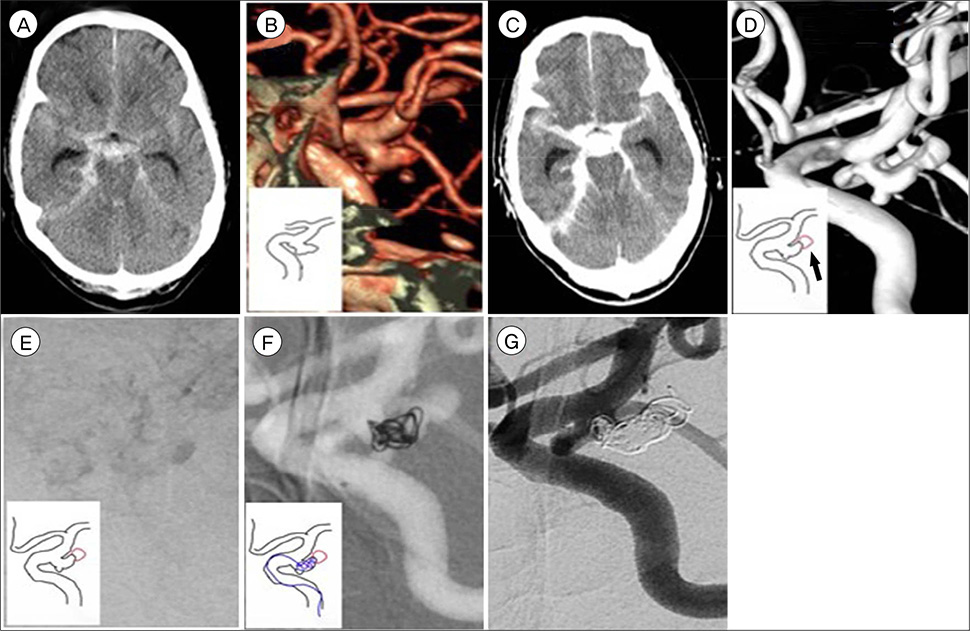J Cerebrovasc Endovasc Neurosurg.
2018 Mar;20(1):24-27. 10.7461/jcen.2018.20.1.24.
A Pseudoaneurysm Associated with a Ruptured Cerebral Aneurysm: Hypothesis on the Formation of the PA and Feasibility of Endovascular Treatment
- Affiliations
-
- 1Department of Neurosurgery, Yeungnam University Medical Center, Daegu, Korea. jyjns@yu.ac.kr
- KMID: 2422556
- DOI: http://doi.org/10.7461/jcen.2018.20.1.24
Abstract
- An intracranial pseudoaneurysm (PA) is a very rare disease and is known to occur in less than 1% of intracranial aneurysms. The pathophysiology and the modality of the proper treatment of PA have not yet been clearly established. We report a case of PA associated with ruptured cerebral aneurysms which was successfully treated by coil embolization, and also discuss the possible hypothesis on the formation of the PA and feasibility of endovascular treatments.
MeSH Terms
Figure
Reference
-
1. Ide M, Kobayashi T, Tamano Y, Hagiwara S, Tanaka N, Kawamura H. Pseudoaneurysm formation at the rupture site of a middle cerebral artery aneurysm--case report. Neurol Med Chir (Tokyo). 2003; 09. 43(9):443–446.2. Kassell NF, Torner JC, Haley EC Jr, Jane JA, Adams HP, Kongable GL. The international cooperative study on the timing of aneurysm surgery. Part 1: overall management results. J Neurosurg. 1990; 07. 73(1):18–36.3. Lempert TE, Halbach VV, Higashida RT, Dowd CF, Urwin RW, Balousek PA, et al. Endovascular treatment of pseudoaneurysms with electrolytically detachable coils. AJNR Am J Neuroradiol. 1998; 05. 19(5):907–911.4. Mori K, Kasuga C, Nakao Y, Yamamoto T, Maeda M. Intracranial pseudoaneurysm due to rupture of a saccular aneurysm mimicking a large partially thrombosed aneurysm (“ghost aneurysm”): radiological findings and therapeutic implications in two cases. Neurosurg Rev. 2004; 10. 27(4):289–293.
Article5. Nomura M, Kida S, Uchiyama N, Yamashima T, Yoshikawa J, Yamashita J, et al. Ruptured irregularly shaped aneurysms: pseudoaneurysm formation in a thrombus located at the rupture site. J Neurosurg. 2000; 12. 93(6):998–1002.
- Full Text Links
- Actions
-
Cited
- CITED
-
- Close
- Share
- Similar articles
-
- Early Treatment of Pseudo-Sac Formation in a Thrombotic Cavity at the Aneurysm Rupture Site
- Endovascular Treatment of Ruptured Dissecting Aneurysms on the P2-3 Segment of the Posterior Cerebral Artery: A Report of Two Cases
- Coil Embolization for Distal Middle Cerebral Artery Aneurysm
- Ruptured Intracranial Dermoid Cyst Associated with Rupture of Cerebral Aneurysm
- Successful Endovascular Treatment of Ruptured Superior Cerebellar Artery Aneurysm Associated with Moyamoya Disease : A Case Report and Review of the Literature


